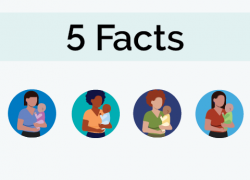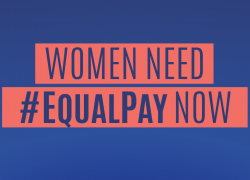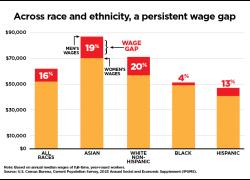The COVID pandemic has thrown into sharp relief the struggles of working women in the U.S., amplifying the challenges they face as they try to succeed in the labor market while juggling family and personal responsibilities.
Even before COVID, though, many were in the position of needing time off but not being able to take it. Indeed, among all working women in the U.S., 1 in 10 had that exact experience in the prior month, according to the 2017-2018 American Time Use Survey Leave Module, a nationally-representative survey by the Bureau of Labor Statistics sponsored by the Women’s Bureau.
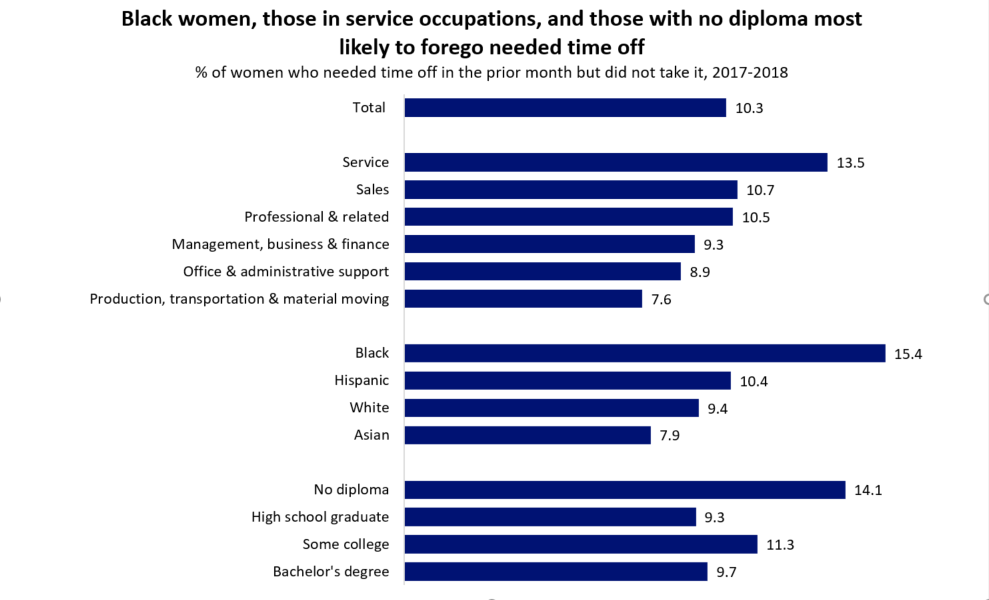
Notes: Based on the main job of employed civilian, non-institutionalized women ages 16 and older. Results not shown for women in Natural resources, construction & maintenance due to insufficient sample size. Hispanics may be of any race. Data: Bureau of Labor Statistics, American Time Use Survey Leave Module 2017-2018. Graphic: U.S. Department of Labor Women's Bureau. (plain text chart)
Women working in service occupations – who were also the least likely to have access to paid leave – were among the most likely to report having needed but not taken leave (13.5%). The shares foregoing leave were also high among African American women (15.4%) and those lacking a high school diploma (14.1%).
On the flip side, women working in production, transportation and material moving, and Asian women were among the least likely to report having needed but not taken leave (7.6% and 7.9% did so, respectively).
Notes: Based on the main job of employed civilian, non-institutionalized women ages 16 and older. Respondents could provide more than one reason. Data: Bureau of Labor Statistics, American Time Use Survey Leave Module 2017-2018. Graphic: U.S. Department of Labor Women's Bureau. (plain text chart)
By far the largest share of all women who needed but didn’t take leave (42%) reported needing to take off for their own illness or medical care. Sizeable shares also reported needing time off for errands or personal needs (26%), or to care for a family member who was ill or had medical needs (20%). Some 8% needed but did not take time off for child care (respondents could report more than one reason for needing time off).
Why in these cases did women not take leave? For many, taking off was simply not an option: 12% said that they could not afford to lose the income, 11% were denied leave, and 10% feared reprisals for taking time off, for instance.
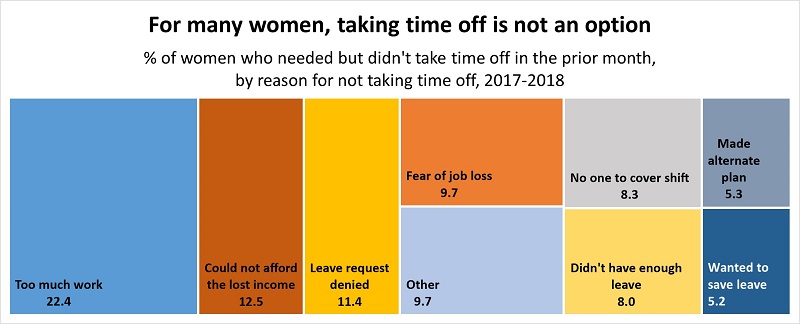
Notes: Based on the main job of employed civilian, non-institutionalized women ages 16 and older. Respondents could provide more than one reason. Data: Bureau of Labor Statistics, American Time Use Survey Leave Module 2017-2018. Graphic: U.S. Department of Labor Women's Bureau. (plain text chart)
Women were equally likely to report foregoing needed time off, whether they had access to paid leave or not. However, the experiences of these two groups of women did differ in other ways. Those who didn’t have paid leave were more likely to say they needed the time off to care for their own illness or medical needs (50% vs. 35%), and were almost five times more likely to say that they didn’t take off because they could not afford to do so (24% vs. 5%).
In contrast, women with paid leave were slightly more likely to say that they needed the leave for errands or other personal reasons (29% vs. 22%) and were more likely to forego the leave because they had too much work (29% vs. 12%).
Notes: Based on the main job of employed civilian, non-institutionalized women ages 16 and older. Data: Bureau of Labor Statistics, American Time Use Survey Leave Module 2017-2018. Graphic: U.S. Department of Labor Women's Bureau. (plain text chart)
The snapshot of data here reveals that pre-pandemic, 1 in 10 women reported unmet need for leave in the month prior, and these needs seemed particularly acute for those lacking paid leave. The struggles brought on by COVID since that time have been so wide ranging, so overwhelming and so salient, that the national conversation about paid leave, personal care and care work responsibilities has been elevated in a new way.
A number of states and cities in the U.S. have already adopted some form of paid leave legislation, as have all other OECD nations. It is past time for policymakers to do the same at the national level, so that we can begin to benefit from a new normal where all workers are able to care for themselves and their loved ones without losing their paychecks in the process.
Gretchen Livingston is a survey statistician in the department’s Women’s Bureau. Follow the bureau on Twitter at @WB_DOL.
EDITOR’S NOTE: This blog was updated from the original to correct a value in the graphic entitled “For many women, taking time off is not an option”.
| Black women, those in service occupations, and those with no diploma most likely to forego needed time off | |
| % of women who needed time off in the prior month but did not take it, 2017-2018 | |
| Total | 10.3 |
| Service occupations | 13.5 |
| Sales | 10.7 |
| Professional & related | 10.5 |
| Management, business & finance | 9.3 |
| Office & administrative support | 8.9 |
| Production, transportation & material moving | 7.6 |
| Black | 15.4 |
| Hispanic | 10.4 |
| White | 9.4 |
| Asian | 7.9 |
| No diploma | 14.1 |
| High school graduate | 9.3 |
| Some college | 11.3 |
| Bachelor's degree | 9.7 |
| Notes: Based on the main job of employed civilian, non-institutionalized women ages 16 and older. Results not shown for women in Natural resources, construction & maintenance due to insufficient sample size. Hispanics may be of any race. | |
| Data: Bureau of Labor Statistics, American Time Use Survey Leave Module 2017-2018 | |
Biggest share of working women who forego time off need it for their own health care. % of women who needed but didn't take time off in the prior month, by reason for needing it, 2017-2018 | |
| For own illness or medical care | 41.6 |
| Errands or personal reasons | 25.7 |
| To care for sick family member | 19.8 |
| Child care | 7.7 |
| Vacation | 4.0 |
| Eldercare | 2.4 |
| Other | 1.1 |
| Birth or adoption | 0.0 |
| Notes: Based on the main job of employed civilian, non-institutionalized women ages 16 and older. Respondents could provide more than one reason. | |
| Data: Bureau of Labor Statistics, American Time Use Survey Leave Module 2017-2018 | |
For many women, taking time off is not an option. % of women who needed but didn't take time off in the prior month, by reason for not taking it, 2017-2018 | |
| Could not afford the lost income | 12.5 |
| No one to cover shift | 8.3 |
| Leave request denied | 11.4 |
| Made alternate plan | 5.3 |
| Fear of job loss/reprisal | 9.7 |
| Didn't have enough leave | 8.0 |
| Wanted to save leave | 5.2 |
| Too much work | 22.4 |
| Other | 9.7 |
| Notes: Based on the main job of employed civilian, non-institutionalized women ages 16 and older. Respondents could provide more than one reason. | |
| Data: Bureau of Labor Statistics, American Time Use Survey Leave Module 2017-2018 | |
Women with no paid leave more likely to forego time off for their own health needs and due to financial concerns. % among women in 2017-2018 who needed but didn't take time off in the prior month who… | ||
| Have paid leave | Don't have paid leave | |
| Needed leave for own illness or medical care | 35.2 | 48.6 |
| Didn't take leave because they couldn't afford to lose the income | 5.1 | 24.3 |
| Notes: Based on the main job of employed civilian, non-institutionalized women ages 16 and older. | ||
| Data: Bureau of Labor Statistics, American Time Use Survey Leave Module 2017-2018 | ||

 U.S. Department of Labor Blog
U.S. Department of Labor Blog

